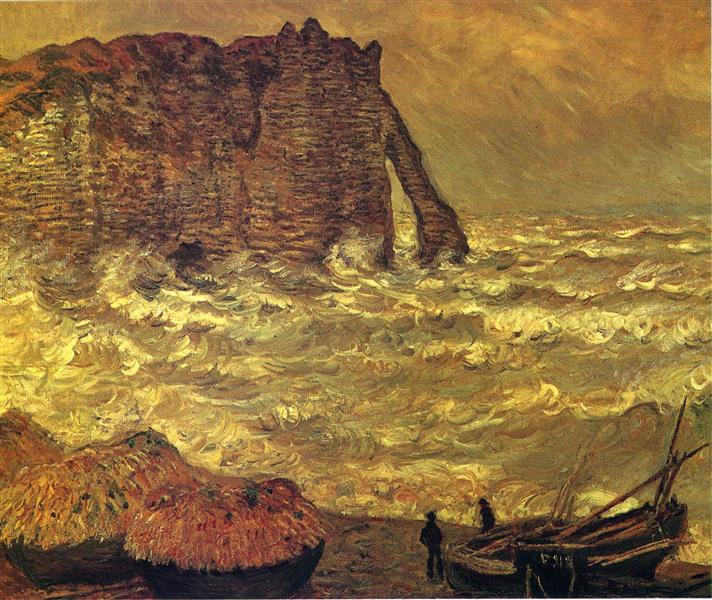Beschreibung
Claude Monet's painting "Mer Agitée À Étretat" (Agitated Sea in Étretat), created in 1883, is a work that encapsulates the mastery of Impressionism and the artist's constant quest to capture the light and movement of nature. Part of Monet's series on the Normandy coast, this piece effectively illustrates the agitation of the sea in front of the cliffs of Étretat, a place that was particularly inspiring to him. The work features a dynamic composition where the force of the water becomes the main protagonist, giving rise to a sensation of movement that feels almost palpable.
The colour palette used by Monet in this work is a key factor contributing to the liveliness of the scene. The blue and green hues of the sea intertwine with the greys and whites of the breaking waves, creating a contrast that reflects the brutality and beauty of the ocean. The loose and rapid brushstroke technique characteristic of Impressionism is evident in the execution of the waves, where the artist not only reproduced the colour of the water, but its vital energy. The vibrant whites of the foam contrast with the depths of the blue, giving the work an almost ethereal luminosity.
Unlike many of his previous works, Mer Agitée À Étretat is devoid of human figures or elements of everyday life, further emphasizing the inhospitable and powerful nature of the sea. In this work, the human being is relegated to the background, allowing the focus to be on natural phenomena. This choice can be interpreted as a reflection of Monet's quest to evoke a sense of the sublime, presenting nature in its purest and most vital state.
Always attentive to light and its effect on objects and the landscape, Monet captures in this work a moment when weather conditions and time of day combine to give a fleeting impression of reality. Light can be seen to play a pivotal role, not only illuminating the waves, but also reflecting off the sky, where soft shades of grey appear, suggesting the arrival of clouds. This attention to the effect of light and atmosphere is what makes this painting, like many of its contemporaries, a testament to Monet’s innovative approach to landscape.
"Mer Agitée À Étretat" is part of the canon of Impressionism, an artistic movement that sought to break with the conventions of classical academic art, advocating a more direct and sensorial representation of reality. Monet's works, including this one in particular, not only contributed to the evolution of modern art, but also invited the viewer to reconsider their relationship with the natural environment in the context of modernity.
This Monet painting not only celebrates the beauty of a tumultuous coastline, but is also a reflection of the artist's obsession with change and the impermanence of nature. With each brushstroke, Monet translates the chaos of the sea into a visual representation that transcends the merely pictorial, inviting the viewer to immerse themselves in a world where nature is not just a background, but a vibrant and living element. His ability to capture the essence of the moment, a distinctive feature of his style, makes "Mer Agitée À Étretat" an essential work to understand the evolution of Impressionist art and, therefore, Monet's own artistic journey.
KUADROS ©, a famous painting on your wall.
Hand-made oil painting reproductions, with the quality of professional artists and the distinctive seal of KUADROS ©.
Painting reproduction service with satisfaction guarantee. If you are not completely satisfied with the replica of your painting, we will refund 100% of your money.

